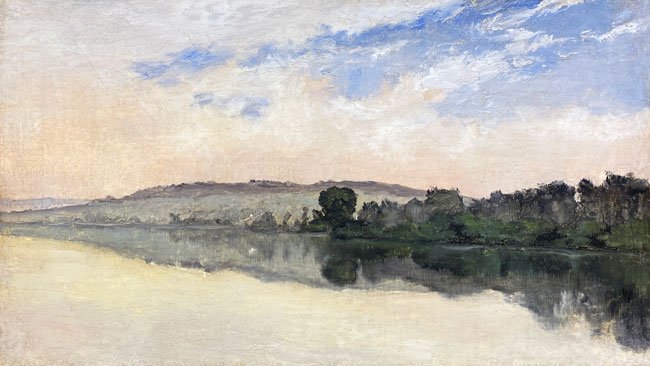RICHARD PARKES BONINGTON PAINTINGS FOR SALE & BIOGRAPHY
RICHARD PARKES BONINGTON
English, 1802-1828
BIOGRAPHY
Richard Parkes Bonington learnt drawing at an early age under his father, a portrait and landscape painter. He came to France aged 15 when his father moved to Calais to go into the tulle and lace business. He was taught there by the watercolourist Louis Francia; he then moved on to Paris and began working at the Louvre, mostly on Flemish landscapes. Soon he met Delacroix, and in 1819 he was admitted to the École des Beaux-Arts in Gros' studio. Though he quickly tired of academic compositions, his watercolour landscapes and seascapes showed promise, and Gros apparently encouraged and nurtured him in this direction.
Travelling around Normandy and Northern France, Bonington started to work directly from nature, producing two watercolours for the 1822 Salon. In the same year his talent for lithography was given full scope with the illustration of Baron Taylor's Picturesque Journey in France of Old (Voyages Pittoresques) for which he provided the landscapes for Normandy and Franche-Comté and most memorably the Rue du Gros-Horloge in Rouen. He exhibited View from Abbeville at the 1824 Paris Salon. Having toured England with Delacroix in 1825, he was attracted to historical painting and composed, in the wake of Sir Walter Scott's Romantic outpourings, medieval and Renaissance scenes: Francis I and the Queen of Navarre, Henry IV and the Spanish Ambassador. Such pretexts for sumptuous settings and costumes would in turn have an impact on Delacroix. During that trip, he became acquainted with Turner's work, which was to mark a pivotal point in his development, turning him from Romanticism to Pre-Impressionism. In the spring of 1826 his stay in Italy, when he visited Naples, Florence, Milan, Bologna and most importantly Venice, resulted in several masterpieces including Venice, the Grand Canal and The Doge's Palace, Venice, exhibited at the 1827 Salon.
The last two years of Richard Parkes Bonington's life were spent partly in Paris in his studio on the Rue St-Lazare, working all hours: he would stop only to entertain friends, the closest of whom was Delacroix. The rest of his time was spent in England. In 1826, he met Lawrence who, in a letter written just after Bonington's death, would assert that no untimely death could have taken away an artist with more promising a talent grown on so outstanding and swift a progress.
Bonington appeared at the onset of the great swing towards watercolour, at a time when, neglected in France, it took pride of place in England. He is the link between the French and the English Schools. For all the originality of Bonington's personal talent, the influence of Constable endured in his work. His landscapes, taken from nature, remain picturesque on the classical lines of the time. At a time when French masters favoured dark shades, they stood out by their colouring and light: clear tones, translucent shadows, limpid skies and waters.
He wrote Remnants and Fragments of Architecture in the Middle Ages (Restes et Fragments d'Architecture au Moyen-Age) (1824) after a stay on the Channel coast. Unassuming and simple to a fault, Jules Joëts remembers in his book St-Omer's School of Fine Arts how Bonington encouraged Cuvelier at his debuts. His gifts as a colourist opened new vistas for the Romantics. The importance he gave to light, to the sky, to their essence, helped to pave the way beyond Corot, for the immediate forerunners of Impressionism, Boudin and Jongkind, so that, together with Delacroix, he was the harbinger both of the end of Romanticism and of a new style of painting.
(Benezit, Dictionary of Artists, Gründ, 2006)
Museum Collections:
Art Institute of Chicago, IL
Harvard University Art Museums
Hermitage Museum, Saint Petersburg
Kimbell Art Museum
Louvre Museum, Paris
Metropolitan Museum of Art
Museum of Fine Arts Boston
National Gallery of Art, Washington, DC
National Gallery, London
National Gallery of Canada, Ottawa
National Gallery of Scotland, Edinburgh
National Portrait Gallery, London
Philadelphia Museum of Art, PA
Dallas Museum of Art, TX
Tate Gallery, London
Victoria and Albert Museum, London
Mark Murray Fine Paintings is a New York gallery specializing in buying and selling 19th century and early 20th century artwork.
RICHARD PARKES BONINGTON
Paintings for sale
Currently there are no available Richard Parkes Bonington paintings for sale at the Mark Murray Gallery.
Please contact us if you are interested in selling your Richard Parkes Bonington paintings or other artwork from the 19th century and early 20th century.
Richard Parkes Bonington Paintings Previously Sold
RICHARD PARKES BONINGTON
Bords de la Seine
Oil on paper laid down on canvas
10½ x 18½ inches (27 x 47 cm)
SOLD


